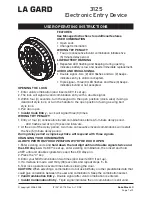
MS
401 |
MS
601 |
MS
801
MS
401W |
MS
601W |
MS
801W
User Manual
MS Series
All-Weather Loudspeaker System
User Manual
8
MS
401 |
MS
601 |
MS
801
MS
401W |
MS
601W |
MS
801W
User Manual
User Manual
MS Series
All-Weather Loudspeaker System
9
TROUBLESHOO
TING
SPECIFICA
TIONS
Most diffi culties with high fi delity equipment result
from loose or poor connections, bad connecting
cables, or switches in the wrong positions.
No Sound
Ensure the Input Selector Switch is set to the
correct position. It is rare for a speaker to fail
completely. When there is no sound, check all the
speaker wire connections and the setting of the
amplifi er’s tape monitor or speaker selector switch.
Dull or Muted Sound
Operating the speakers at unsafe power level
activates the automatic tweeter protector. Turn
down the amplifi er volume control and the protector
will automatically restore signal to the tweeter. Also
check the amplifi er’s tone controls or “high fi lter”
switch.
Distorted Sound
Distortion at moderate levels can be caused by
loose connections, or stray wire strands shorting
out adjacent wires at the amplifi er or speaker
terminals. If you hear distortion, or any other type of
buzzing or rattling sound from an individual driver,
contact your Quest Engineering dealer. Distortion at
high levels is the result of either reaching the power
limit of the amplifi er or of the speaker. Turn down
the volume to prevent damage.
Noise or Hum
Continuous background noise or hum are always
from the electronic equipment and not from the
speakers.
General Troubleshooting Tips
Buzzes and Noise in the Sound System:
Getting
rid of unwanted noises is a study in itself. Most of
the noise, (apart from undesir-able program) will fall
into three categories.
(A) White noise.
This is the hiss that suggests that
the gain structure is set incorrectly. Something in
the signal chain is boosting too much or an input
is set too sensitive. If your equipment has gain
Quest Engineering MS Series Specifi cations
MS 401 / 401W
Specifi cations
Peak Power
100W
Power Handling
50W
Type
Bass Refl ex
Impedance Nominal
8Ω
Transformer Tappings
25W / 20W / 15W / 10W + 8Ω Direct
Components
LF
4" Poly Propelyne Cone, Rubber Surround, 25 mm Voice Coil
HF
Dome Tweeter PEI Diaphragm, 20 mm Voice Coil
Angle of coverage
90˚ x 90˚
Sensitivity 1W @ 1 meter
88 dB
Max SPL
108 dB
Frequency Response
80Hz-20Khz ±4dB
Crossover Frequency
3000Hz
Crossover
12 dB
Enclosure Material
UV Stabilised ABS
Bracket Material
Aluminium
Grill Material
Aluminium
Dimensions
153 mm x 180.5 mm x 278 mm
Weight
2.6 kg
Shipping Dimensions
203 mm x 226 mm x 319 mm
Shipping Weight
3.3 kg
switches on it, set them all the same. If the switch
is la4dB, set them all to that fi gure. If one
piece of equipment seems to be overloading, set
them all to -10/-20dB and be prepared to boost
the input level. The last unit in the chain should be
set to +4 dB at the output stage if possible when
connected to the line level input.
(B) Low frequency hum.
This is often caused by
noise from the power leads being picked up by
the audio signal cables. The preferred solution is
to connect up your system with “balanced” XLR
microphone cables. Especially if you are running the
cables a long distance, (more than 5Mtrs /15 Ft).
The other solution is to make sure that your audio
cables are as far from power cables as possible.
(C) Buzz.
Sometimes you can experience a hum
and buzz together. A buzz is almost always a
problem with the “earthing” of the system. It will
often occur when you have the system powered
from sperate power outlets in the same building
or audio and lighting sharing a common power
circuit. Even when the audio and lighting systems
are powered from separate sources, there can still
be a common earth between them. For example,
a smoke machine may be powered from the
lighting system, yet the trigger mechanism could
be connected to the audio system through the
audio multi-core/snake. An earth connection
between the audio and lighting will now exist and
a buzz could be amplifi ed in the audio system. The
simple solution is to power your audio circuit and
everything con-nected to it from the same source.
If the buzz persists, check your signal cables, one
may have an earth/shield disconnected.
A cheap but possibly life saving investment is a
domestic power tester to check that the power
supply sockets are correctly wired. Faulty or
incorrectly wired power is a booby trap more
common than you think.
It is wise to avoid switching on or off devices
in the signal path while the speaker system is
powered and turned up. Otherwise loud clicks
and bangs could result. When shutting down the
system, always turn the speakers off fi rst. This is
to prevent the speaker amplifying the sound of the
other equipment in the chain being shut down.
The reverse is true when powering up. Mixers
and effects on fi rst, power amplifi ers or powered
speakers on last.
All specifi cations are correct at time of printing, Quest Engineering reserves the right to change
specifi cations at any time and won’t be held responsible for any typographic errors in this publication.
Summary of Contents for MS 401
Page 7: ...www questaudio net...

























